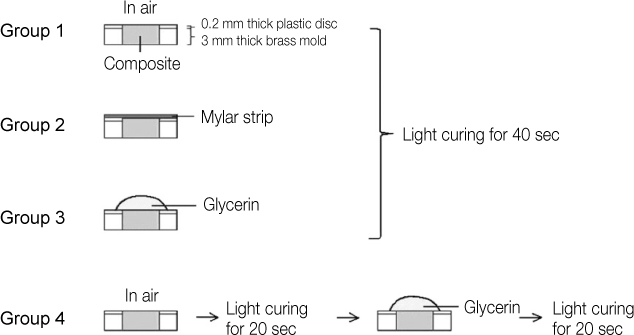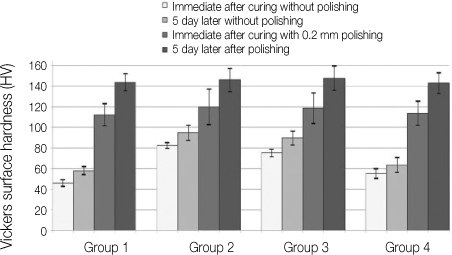J Korean Acad Conserv Dent.
2011 Nov;36(6):483-489. 10.5395/JKACD.2011.36.6.483.
Effect of glycerin on the surface hardness of composites after curing
- Affiliations
-
- 1Department of Dentistry, Seoul National University School of Dentistry, Seoul, Korea.
- 2Department of Conservative Dentistry, Seoul National University School of Dentistry and Dental Research Institute, Seoul, Korea. inboglee@snu.ac.kr
- KMID: 2176601
- DOI: http://doi.org/10.5395/JKACD.2011.36.6.483
Abstract
OBJECTIVES
The purpose of this study was to examine the effect of glycerin topical application on the surface hardness of composite after curing.
MATERIALS AND METHODS
A composite (Z-250, 3M ESPE) was packed into a disc-shaped brass mold and light cured according to one of the following protocols. Group 1 (control) was exposed to air and light cured for 40 sec, group 2 was covered with a Mylar strip and light cured for 40 sec, group 3 was surface coated with glycerin and light cured for 40 sec, and group 4 was exposed to air and light cured for 20 sec and then surface coated with glycerin and cured for additional 20 sec. Twenty specimens were prepared for each group. The surface hardnesses of specimens were measured with or without polishing. Five days later, the surface hardness of each specimen was measured again. Data were analyzed by three-way ANOVA and Tukey's post hoc tests.
RESULTS
The surface hardnesses of the unpolished specimens immediately after curing decreased in the following order: group 2 > 3 > 4 > 1. For the polished specimens, there was no significant difference among the groups. Within the same group, the hardness measured after five days was increased compared to that immediately after curing, and the polished specimens showed greater hardness than did the unpolished specimens.
CONCLUSIONS
The most effective way to increase the surface hardness of composite is polishing after curing. The uses of a Mylar strip or glycerin topical application before curing is recommended.
Keyword
MeSH Terms
Figure
Reference
-
1. Shawkat ES, Shortall AC, Addison O, Palin WM. Oxygen inhibition and incremental layer bond strengths of resin composites. Dent Mater. 2009. 25:1338–1346.
Article2. Peutzfeldt A, Asmussen E. Oxygen-inhibited surface layers on Microfill Pontic. Acta Odontol Scand. 1989. 47:31–33.
Article3. Kim SY, Cho BH, Baek SH, Lee IB. Is an oxygen inhibition layer essential for the interfacial bonding between resin composite layers? J Korean Acad Conserv Dent. 2008. 33:405–412.
Article4. Park SH, Krejci I, Lutz F. Hardness of celluloid strip-finished or polished composite surfaces with time. J Prosthet Dent. 2000. 83:660–663.
Article5. Bergmann P, Noack MJ, Roulet JF. Marginal adaptation with glass-ceramic inlays adhesively luted with glycerine gel. Quintessence Int. 1991. 22:739–744.6. Asmussen E. Restorative resins: hardness and strength vs. quantity of remaining double bonds. Scand J Dent Res. 1982. 90:484–489.
Article7. Rueggeberg FA, Craig RG. Correlation of parameters used to estimate monomer conversion in a light-cured composite. J Dent Res. 1988. 67:932–937.
Article8. Tak HS, Park SJ. Influences of camphroquinone on the properties of composites. J Korean Acad Conserv Dent. 2001. 26:41–50.9. Kim CG, Moon HJ, Shin DH. Optimal combination of 3-component photoinitiaiton system to increase the degree of conversion of resin monomers. J Korean Acad Conserv Dent. 2011. 36:313–323.
Article10. Ruyter IE., Oysaed H. Conversion in different depths of ultraviolet and visible light activated composite materials. Acta Odontol Scand. 1982. 40:179–192.
Article11. Gauthier MA, Stangel I, Ellis TH, Zhu XX. Oxygen inhibition in dental resins. J Dent Res. 2005. 84:725–729.
Article12. Ruyter IE. Unpolymerized surface layers on sealants. Acta Odontol Scand. 1981. 39:27–32.
Article13. Helvatjoglou-Antoniadi M, Papadogianis Y, Koliniotou-Kubia E, Kubias S. Surface hardness of light-cured and self-cured composite resins. J Prosthet Dent. 1991. 65:215–220.
Article14. Watts DC, McNaughton V, Grant AA. The development of surface hardness in visible light-cured posterior composites. J Dent. 1986. 14:169–174.
Article15. Watts DC, Amer OM, Combe EC. Surface hardness development in light-cured composites. Dent Mater. 1987. 3:265–269.
Article16. Asmussen E, Peutzfeldt A. Influence of specimen diameter on the relationship between subsurface depth and hardness of a light-cured resin composite. Eur J Oral Sci. 2003. 111:543–546.
Article17. Hachiya Y, Iwaku M, Hosoda H, Fusayama T. Relation of finish to discoloration of composite resins. J Prosthet Dent. 1984. 52:811–814.
Article18. Hannah CM, Smith GA. The surface finish of composite restorative materials. Br Dent J. 1973. 135:483–488.
Article
- Full Text Links
- Actions
-
Cited
- CITED
-
- Close
- Share
- Similar articles
-
- THE INFLUENCE OF WATTAGE AND CURING TIME OF MICROWAVE ENERGY ON PHYSICAL PROPERTIES OF THE DENTURE BASE RESIN
- Evaluation of the Changes in Polymerization of TheraCal LC with Various Light-curing Time and Distance
- Errors in light-emitting diodes positioning when curing bulk fill and incremental composites: impact on properties after aging
- Surface hardness of the dental composite cured by light that penetrate tooth structure according to thickness of tooth structure, light intensity and curing time
- Effect of light source and shade on depth of cure of composites



